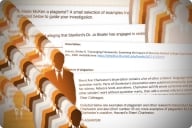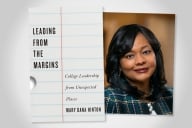You have /5 articles left.
Sign up for a free account or log in.
John Willinsky's new book is a history of thought and learning -- combined with analysis of the development of intellectual property concepts and a case for open-access publishing. Willinsky looks to intellectual history to illustrate his points about open access today. The result is The Intellectual Properties of Learning: A Prehistory from Saint Jerome to John Locke (University of Chicago Press).
Willinsky, the Khosla Family Professor of Education at Stanford University and the director of the Public Knowledge Project, responded via email to questions about his new book.
Q: Most writing about open access does not begin with Saint Jerome, who lived in the fourth and fifth centuries. What made you think to do an intellectual history of learning as a way to point toward an argument about open access and intellectual property?
A: Indeed, like many I regarded open access to research and scholarship to be an internet artifact, a Napster spin-off. But then I was troubled -- as an open-access researcher, advocate and tool builder -- by the question of where in the world we picked up this sense of a right to research. Where was the history of this right? This first led me to John Locke’s influential concept of property, in which we begin with a world held in common. Locke was also involved in lobbying for the first copyright law in the modern sense, although he died before it came to pass with the Statute of Anne 1710. It was entitled “An Act for the Encouragement of Learning” and had multiple access-to-knowledge clauses.
So the book ends with my beginning point, as I then had to understand how historically, Locke’s world held in common might have been preserved within the realm of learning. This led me to medieval monasticism, in which not even a book or a pen, as Saint Benedict put in the seventh-century rule, was to be held privately. In such a communal setting, Saint Jerome had turned his fourth-century monastic cell near Bethlehem into a Christian publishing house with a great regard for the intellectual, as well as the spiritual, properties of texts for which he sought to provide readers with far greater access, by translation, editing, commentary and distribution networks.
Q: How would you describe the lessons of premodern history with regard to learning and the ideas of sharing that learning?
A: In the medieval era, prior to the universities, the treatment of texts by learned men and women in abbeys and religious houses began to reflect a sense of rights and responsibilities. They included a right to use another’s work through copying, commentary, translation and the preparation of more accurate editions, all of it intended to both credit the author and extend the right of others to such works. Authorship became an increasingly important intellectual property of texts, not in any commercial sense, but through commentaries in which the text’s “author” became a focus of interpretation and meaning.
[These] access and use rights thrived through an elaborate system of monastic sponsorship, which endowed religious houses with the means and materials to create manuscripts that illuminated the monastics’ discipline, devotion and learning, which attracted further gifts in turn. This uneven and often sporadic sponsorship afforded monasteries, and later the medieval universities, a spirit of both communality and autonomy by which these institutions were able to advance the intellectual properties of learning.
Q: As universities evolved, how did that change understandings of learning and intellectual property?
A: I argue that the common origin stories of the medieval universities miss out on the extent to which Europe was swept up in the grand intellectual (access) rush of learning’s great translation movement from Arabic into Latin during the 12th and 13th centuries. For the first time, scholars had access to a great mass of ancient Greek and medieval Islamic learning. Schools in Oxford, Paris, Bologna and elsewhere set about teaching Aristotle and his Muslim commentators, as well as the science and math of Islamic scholars.
Still, the faculty denied access to women, who had been an integral part of monastic learning, and fought with the church over their autonomy. They pursued more rigorous rules of use, attribution and editing, while remaining dependent on generous acts of sponsorship, such as Thomas Bodley’s magnificent early 17th-century “public library” at Oxford, with donated manuscripts and a (faulty) deal with the Stationers’ Company for one copy of every book printed.
Q: What is your vision for how open access should work today?
A: Taking a leaf from the communality and cooperation among scholars across the centuries (despite many lapses and moral failures), in which the libraries form the constant center, I am among those who see a path to universal open access through research libraries moving their journal subscriptions from exclusive access to open access. These libraries already subscribe, in principle, to open access, and do so in practice, with SCOAP3’s particle physics journals, the Open Library of the Humanities, Knowledge Unlatched and other projects.
Libraries should not go at it alone in this, as the research funding agencies would gain greatly in efficiency and impact by paying publishers directly for publishing the research they sponsor. The “article processing charges” (APC), which grants cover, may work for biomedical open access, but they are discouraging my colleagues from even considering open access in most other fields.
Q: Your book appears to be copyrighted by the University of Chicago Press. And of course it's hard to change from today's system to another one. What steps have you taken or would you encourage others to take to promote more of the ideals of learning that you discuss in the book?
A: Actually, the University of Chicago Press, among its own ongoing experiments in increasing access, has enabled me to make an open-access copy of the final draft available online at Stanford University. More broadly, my work on open access is divided between studying access to knowledge and helping scholars move journals and presses to open access by working with the Public Knowledge Project to build open-source (free) scholarly publishing platforms, principally Open Journal Systems, which, forgive the boast, more than 10,000 peer-reviewed journals are now using to increase those intellectual properties of access, accreditation, autonomy, communality, sponsorship and use.
I hold that these six intellectual properties of learning (with a nod to Robert K. Merton’s four scientific imperatives) continue to set research and scholarship apart from other forms of intellectual property. These properties need to be defended and extended anew with the digital era that this form of work continues “to promote the progress of science and useful arts,” as the U.S. Constitution frames its intellectual property clause.








